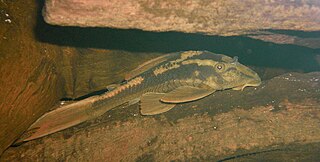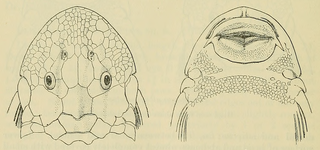
Hypostomus is a genus of catfish in the family Loricariidae. They are native to tropical and subtropical South America. H. plecostomus is the popular freshwater aquarium fish formerly known as Plecostomus plecostomus. The taxonomic structure of the Loricariidae is still being expanded by scientists. Hypostomus is a highly species-rich and widely distributed catfish genus.
Hypostomus rhantos is a species of catfish in the family Loricariidae. It is native to South America, where it occurs in the Ventuari River as well as the upper Orinoco, ranging from above Puerto Ayacucho to the Casiquiare in Venezuela. The species reaches 19.6 cm SL. Its specific epithet, rhantos, derives from a Greek word meaning "speckled" and refers to the species' pattern of small spots.
Hypostomus kuarup is a species of catfish in the family Loricariidae. It is native to South America, where it occurs in the Culuene River in the Xingu River basin in the state of Mato Grosso in Brazil. It is typically found in rapids within its range, although the type locality of the species has subsequently dried out due to the construction of a nearby dam. Despite this, it is still known to inhabit rapids above and below the dammed area, as well as a fish ladder built near the type locality. It is sympatric with its congener Hypostomus faveolus.
Hypostomus latifrons is a species of catfish in the family Loricariidae. It is native to South America, where it occurs in the Paraguay River basin. The species reaches 28.7 cm SL and is believed to be a facultative air-breather.
Hypostomus spiniger, sometimes known as the spiny plated pleco, is a disputed species of catfish in the family Loricariidae with a complex history of classification.
Hypostomus macushi is a species of catfish in the family Loricariidae. It is native to South America, where it occurs in the Essequibo River, the Ireng River, the Rupununi, and the Takutu River along the border of Brazil and Guyana. It is typically seen near dead, submerged wood in areas with moderate to fast-flowing water. The species reaches 17 cm SL and is believed to be a facultative air-breather. Its specific epithet, macushi, refers to the Macushi people of the Rupununi region who collected specimens of the species and are stated to have provided the authors of its description, Jonathan W. Armbruster and Lesley S. de Souza, with hospitality while in Guyana.
Hypostomus mutucae is a species of catfish in the family Loricariidae. It is native to South America, where it occurs in the Cuiabá River basin in Brazil. The species reaches 10.9 cm SL.
Hypostomus weberi is a species of catfish in the family Loricariidae. It is native to South America, where it occurs in the middle Rio Negro in Brazil. One record of the species' occurrence refers to a "río Cicipa", which is thought to possibly correspond with the Siapa River, a tributary of the Casiquiare in Venezuela. The species is typically found in rapids or flooded forest environments. It reaches 17.5 cm SL and is known to feed on detritus. Its specific epithet, weberi, honors Claude Weber of the Natural History Museum of Geneva, for his contributions to knowledge of the genus Hypostomus.
Hypostomus arecuta is a species of catfish in the family Loricariidae. It is a freshwater fish native to South America, where it occurs in the Paraná River in Argentina.

Hypostomus basilisko is a species of catfish in the family Loricariidae. It is native to South America, where it occurs in the Salobra River basin, which is part of the Paraguay River basin in the state of Mato Grosso do Sul in Brazil.
Hypostomus carinatus is a species of catfish in the family Loricariidae. It is native to South America, where it occurs in the middle Amazon River basin. The species reaches 24.8 cm SL and is believed to be a facultative air-breather.

Hypostomus commersoni is a species of catfish in the family Loricariidae. It is native to South America, where it occurs in the Paraná River drainage, including the Iguazu River, the Paraguay River, the Río de la Plata, and the Dulce River. It is typically found in rivers with muddy substrates and moderate currents. The water that H. commersoni inhabits usually has a temperature of 16.8 to 27.8 °C, a pH of 7.2 to 9.2, a turbidity of 23.7 to 442 NTU, an oxygen concentration of 6.1 to 9.1 mg/L, and a conductivity of 1.087 to 2.654 μS/cm.
Hypostomus delimai is a species of catfish in the family Loricariidae. It is native to South America, where it occurs in the basins of the Araguaia River and the Tocantins River in Brazil. It is typically found in areas with turbid water, riparian vegetation, and a substrate composed of rocks and sand. It is known to be sympatric with other species of Hypostomus, including H. faveolus and H. pyrineusi, as well as species of Aphanotorulus. The species reaches 25.3 cm in standard length and is believed to be a facultative air-breather.
Hypostomus ericius, sometimes known as the beige cochliodon, is a species of catfish in the family Loricariidae. It is native to South America, where it occurs in the upper Amazon River drainage in Peru. The species reaches 18.7 cm in standard length.

Hypostomus goyazensis is a species of catfish in the family Loricariidae. The species reaches 26 cm in total length and is believed to be a facultative air-breather. Its specific epithet is believed to refer to the Brazilian state of Goiás, in which it is found.

Hypostomus nigromaculatus is a species of catfish in the family Loricariidae. It is native to South America, where it occurs in the middle and upper Paraná River basin in Brazil. The species reaches 10.2 cm in standard length and is believed to be a facultative air-breather.
Hypostomus pantherinus is a species of catfish in the family Loricariidae. It is native to South America, where it occurs in the Madeira River basin in Brazil. The species reaches at least 4.8 cm in standard length and is believed to be a facultative air-breather. Although originally described by Rudolf Kner in 1854 based on a single specimen from the Guaporé River basin in Brazil, Hypostomus pantherinus was redescribed in 2021 and its range was found to also include Bolivia.
Hypostomus peckoltoides is a species of catfish in the family Loricariidae. It is native to South America, where it occurs in the Cuiabá River in the upper Paraguay River basin in Brazil. It is typically found in environments with turbid water, a substrate composed of rocks and sand, and various types of riparian vegetation. It is known to be syntopic with other species of Hypostomus, including H. boulengeri, H. cochliodon, H. latifrons, H. latirostris, and H. regani.
Hypostomus plecostomoides is a species of catfish in the family Loricariidae. It is native to South America, where it occurs in the Meta River basin in Colombia. The species reaches 25.6 cm in total length and is believed to be a facultative air-breather. Its specific epithet, plecostomoides, may refer to perceived similarity between it and the species Hypostomus plecostomus, which it does not overlap with in distribution, although it may also refer to the now-invalid genus Plecostomus.
Hypostomus roseopunctatus is a species of catfish in the family Loricariidae. It is native to South America, where it occurs in the Uruguay River basin in the Río de la Plata system in Argentina and Brazil. The species reaches 43.3 cm in total length, can weigh up to at least 796 g, and is believed to be a facultative air-breather.




